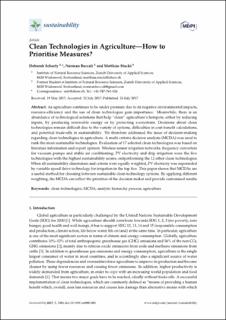Bitte benutzen Sie diese Kennung, um auf die Ressource zu verweisen:
https://doi.org/10.21256/zhaw-4832| Publikationstyp: | Beitrag in wissenschaftlicher Zeitschrift |
| Art der Begutachtung: | Peer review (Publikation) |
| Titel: | Clean technologies in agriculture : how to prioritise measures? |
| Autor/-in: | Scharfy, Deborah Boccali, Norman Stucki, Matthias |
| DOI: | 10.21256/zhaw-4832 10.3390/su9081303 |
| Erschienen in: | Sustainability |
| Band(Heft): | 9 |
| Heft: | 8 |
| Erscheinungsdatum: | 2017 |
| Verlag / Hrsg. Institution: | MDPI |
| ISSN: | 2071-1050 |
| Sprache: | Englisch |
| Schlagwörter: | Agriculture; LCA; Solar; Cleantech |
| Fachgebiet (DDC): | 338.927: Umweltökonomie und nachhaltige Entwicklung 630: Landwirtschaft |
| Zusammenfassung: | As agriculture continues to be under pressure due to its negative environmental impacts, resource-efficiency and the use of clean technologies gain importance. Meanwhile, there is an abundance of technological solutions that help “clean” agriculture’s hotspots, either by reducing inputs, by producing renewable energy or by protecting ecosystems. Decisions about clean technologies remain difficult due to the variety of options, difficulties in cost-benefit calculations, and potential trade-offs in sustainability. We therefore addressed the issue of decision-making regarding clean technologies in agriculture. A multi-criteria decision analysis (MCDA) was used to rank the most sustainable technologies. Evaluation of 17 selected clean technologies was based on literature information and expert opinion. Wireless sensor irrigation networks, frequency converters for vacuum pumps and stable air conditioning, PV electricity and drip irrigation were the five technologies with the highest sustainability scores, outperforming the 12 other clean technologies. When all sustainability dimensions and criteria were equally weighted, PV electricity was superseded by variable speed drive technology for irrigation in the top five. This paper shows that MCDAs are a useful method for choosing between sustainable clean technology options. By applying different weighting, the MCDA can reflect the priorities of the decision maker and provide customised results. |
| URI: | https://digitalcollection.zhaw.ch/handle/11475/11715 |
| Volltext Version: | Publizierte Version |
| Lizenz (gemäss Verlagsvertrag): | CC BY 4.0: Namensnennung 4.0 International |
| Departement: | Life Sciences und Facility Management |
| Organisationseinheit: | Institut für Umwelt und Natürliche Ressourcen (IUNR) |
| Publiziert im Rahmen des ZHAW-Projekts: | Applying Life Cycle Assessment for the mitigation of environmental impacts South African agrifood products |
| Enthalten in den Sammlungen: | Publikationen Life Sciences und Facility Management |
Dateien zu dieser Ressource:
| Datei | Beschreibung | Größe | Format | |
|---|---|---|---|---|
| 2017_Scharfy_Clean_technologies_in_agriculture.pdf | 2.27 MB | Adobe PDF |  Öffnen/Anzeigen |
Zur Langanzeige
Scharfy, D., Boccali, N., & Stucki, M. (2017). Clean technologies in agriculture : how to prioritise measures? Sustainability, 9(8). https://doi.org/10.21256/zhaw-4832
Scharfy, D., Boccali, N. and Stucki, M. (2017) ‘Clean technologies in agriculture : how to prioritise measures?’, Sustainability, 9(8). Available at: https://doi.org/10.21256/zhaw-4832.
D. Scharfy, N. Boccali, and M. Stucki, “Clean technologies in agriculture : how to prioritise measures?,” Sustainability, vol. 9, no. 8, 2017, doi: 10.21256/zhaw-4832.
SCHARFY, Deborah, Norman BOCCALI und Matthias STUCKI, 2017. Clean technologies in agriculture : how to prioritise measures? Sustainability. 2017. Bd. 9, Nr. 8. DOI 10.21256/zhaw-4832
Scharfy, Deborah, Norman Boccali, and Matthias Stucki. 2017. “Clean Technologies in Agriculture : How to Prioritise Measures?” Sustainability 9 (8). https://doi.org/10.21256/zhaw-4832.
Scharfy, Deborah, et al. “Clean Technologies in Agriculture : How to Prioritise Measures?” Sustainability, vol. 9, no. 8, 2017, https://doi.org/10.21256/zhaw-4832.
Alle Ressourcen in diesem Repository sind urheberrechtlich geschützt, soweit nicht anderweitig angezeigt.